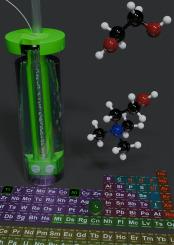采用环保的深共晶溶剂对镍钛丝进行电抛光
IF 5.4
2区 化学
Q2 CHEMISTRY, PHYSICAL
Colloids and Surfaces A: Physicochemical and Engineering Aspects
Pub Date : 2025-10-11
DOI:10.1016/j.colsurfa.2025.138372
引用次数: 0
摘要
镍钛合金由于其独特的形状记忆和超弹性性能,在生物医学和工业应用中得到了广泛的应用。然而,优化镍钛丝的表面质量对于提高其性能和寿命至关重要。本研究研究了一种基于氯化胆碱和乙二醇的深度共晶溶剂(DES)作为传统电解质的可持续替代品,对镍钛丝进行电抛光。系统地研究了施加电压和加工时间对表面质量的影响。通过扫描电子显微镜、白光干涉测量、拉曼光谱和x射线光电子能谱(XPS)以及溅射辅助分析对表面进行了表征。在11.5 V下电抛光产生了逐渐均匀的表面光滑(30分钟后Sa从0.62 μm降低到0.39 μm),而在16 V下电抛光在5分钟内迅速降低到Sa = 0.28 μm,尽管由于气体析出而不均匀。控制溅射的XPS显示,与化学蚀刻的基材相比,电抛光样品的氧化层更薄。总体而言,基于des的方法可以显著改善表面形貌和氧化物还原,同时通过消除有害酸来最大限度地减少对环境的影响。本文章由计算机程序翻译,如有差异,请以英文原文为准。

Electropolishing of NiTi wires using an eco-friendly deep eutectic solvent
Nickel-Titanium alloys are widely used in biomedical and industrial applications due to their unique shape memory and superelastic properties. However, optimizing the surface quality of NiTi wires is essential to enhance their performance and longevity. This study investigates the electropolishing of NiTi wires using a deep eutectic solvent (DES) based on choline chloride and ethylene glycol as a sustainable alternative to conventional electrolytes. The effects of applied voltage and processing time on surface quality were systematically studied. Surface characterization was performed by scanning electron microscopy, white light interferometry, Raman spectroscopy, and X-ray photoelectron spectroscopy (XPS) with sputter-assisted analysis. Electropolishing at 11.5 V yielded a gradual and homogeneous surface smoothing (Sa reduced from 0.62 m to 0.39 m after 30 min), whereas 16 V enabled a rapid decrease to Sa = 0.28 m within 5 min, albeit with less uniformity due to gas evolution. XPS with controlled sputtering revealed thinner oxide layers on electropolished samples compared to the chemically etched base material. Overall, the DES-based approach enables significant improvements in surface morphology and oxide reduction while minimizing environmental impact by eliminating hazardous acids.
求助全文
通过发布文献求助,成功后即可免费获取论文全文。
去求助
来源期刊
CiteScore
8.70
自引率
9.60%
发文量
2421
审稿时长
56 days
期刊介绍:
Colloids and Surfaces A: Physicochemical and Engineering Aspects is an international journal devoted to the science underlying applications of colloids and interfacial phenomena.
The journal aims at publishing high quality research papers featuring new materials or new insights into the role of colloid and interface science in (for example) food, energy, minerals processing, pharmaceuticals or the environment.

 求助内容:
求助内容: 应助结果提醒方式:
应助结果提醒方式:


